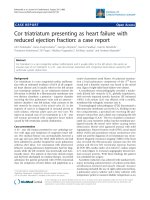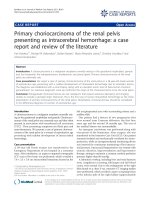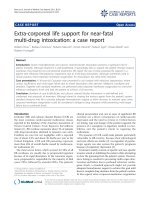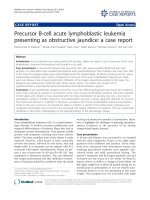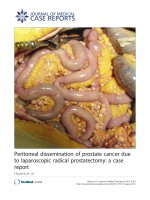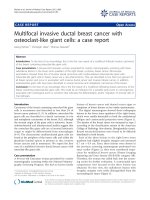Báo cáo y học: " Neurological presentation of Whipple''''s disease after long-term antibiotic treatment: a case report" ppsx
Bạn đang xem bản rút gọn của tài liệu. Xem và tải ngay bản đầy đủ của tài liệu tại đây (221.41 KB, 3 trang )
BioMed Central
Page 1 of 3
(page number not for citation purposes)
Journal of Medical Case Reports
Open Access
Case report
Neurological presentation of Whipple's disease after long-term
antibiotic treatment: a case report
Felix Gundling*
1,2
, Henning Wittenburg
2
, Andrea Tannapfel
3
and
Joachim Mossner
2
Address:
1
Second Department of Medicine, Bogenhausen Hospital, Academic Teaching Hospital, Technical University of Munich, Munich,
Germany,
2
Second Department of Medicine, University of Leipzig, Leipzig, Germany and
3
Department for Pathology, University of Leipzig,
Leipzig, Germany
Email: Felix Gundling* - ; Henning Wittenburg - ;
Andrea Tannapfel - ; Joachim Mossner -
* Corresponding author
Abstract
Introduction: Whipple's disease is a rare systemic infectious disorder caused by Tropheryma
whipplei.
Case presentation: We report a 68-year-old male with Whipple's disease of the central nervous
system following long-term antibiotic therapy and many years after the initial clinical onset.
Conclusion: The combination of trimethoprim and sulphamethoxazole does not prevent or cure
involvement of the central nervous system in all patients with Whipple's disease. If relapse of the
central nervous system occurs treatment with meropenem might be a useful alternative.
Introduction
Whipple's disease (WD) is a rare condition caused by
infection with Gram-positive bacilli (Tropheryma whipplei)
characterised by fever, diarrhoea, arthropathy, apathy and
cranial nerve lesions, among other symptoms [1]. WD of
the central nervous system (CNS) can be observed even
after long-term antibiotic therapy and many years after
clinical onset [2,3].
Case presentation
We evaluated a 68-year-old man, who presented with
drowsiness, progressive memory loss, dysarthria and mus-
cular weakness, which was observed 6 months previously.
On physical examination, the patient was somnolent and
not adequately orientated. Neurological examination
revealed complete paresis of the oculomotor nerve and
incomplete paresis of the abducent nerves, mild weakness
of bilateral lower limbs and a left Babinski sign. The
patient's past medical history was remarkable for WD. In
1992, the patient experienced weight loss and diarrhoea
resulting in a severe malabsorption syndrome combined
with diffuse arthropathy. WD was diagnosed upon posi-
tive staining of macrophages of the duodenal mucosa for
peroxidase acid-Schiff (PAS) reagent. Long-term antibiotic
therapy was carried out with doxycycline (2 × 100 mg),
which was changed later to trimethoprim-sulphamethox-
azole (2 × 160/800 mg) because of photoallergic reac-
tions. The symptoms improved rapidly accompanied with
gradual reconstitution of the villous architecture of the
small intestine. Antibiotic therapy was discontinued in
1995 after 36 months of treatment.
The patient's past medical history further revealed a thora-
cotomy in 1987 for complete removal of a bronchial car-
Published: 3 June 2008
Journal of Medical Case Reports 2008, 2:191 doi:10.1186/1752-1947-2-191
Received: 2 September 2007
Accepted: 3 June 2008
This article is available from: />© 2008 Gundling et al; licensee BioMed Central Ltd.
This is an Open Access article distributed under the terms of the Creative Commons Attribution License ( />),
which permits unrestricted use, distribution, and reproduction in any medium, provided the original work is properly cited.
Journal of Medical Case Reports 2008, 2:191 />Page 2 of 3
(page number not for citation purposes)
cinoid of the left bronchus. No chemotherapy was
administered and there was no sign of relapse or metasta-
sis in follow-up examinations.
He represented after an interval of 12 years. Laboratory
tests on admission to the hospital displayed an increased
C-reactive protein level (18.6 mg/l: normal range -5) and
an elevated leukocyte count (11.3 × 10
9
leucocytes/l: nor-
mal range 4 to 9/nl). All other routine laboratory results
were within normal limits. Lumbar puncture revealed a
mildly elevated protein level (510 mg/l: normal range 150
to 450 mg/l) and a modest pleocytosis (6 Mpt/l). Cerebro-
spinal fluid (CSF) glucose was within normal limits.
Examinations of cell pellets obtained by cytocentrifuga-
tion of CSF samples were positive for PAS staining (Figure
1). Polymerase chain reaction (PCR) testing of the CSF for
the causative agent of WD was positive resulting in strong
presumptive evidence of CNS infection by Tropheryma
whipplei. Brain computed tomography (CT) displayed dif-
fuse hypodense lesions in subependymal grey matter. An
endoscopy of the upper gastrointestinal tract revealed ero-
sive duodenitis with no histopathological characteristics
for WD. Brain biopsy was not performed. Intravenous
antibiotic treatment with meropenem (2 × 1 g) for 2
weeks was carried out followed by treatment with oral tri-
methoprim-sulphamethoxazole (2 × 160/800 mg)
according to the study protocol of the first prospective
antibiotic trial in WD ('Study for the Initial treatment of
Morbus Whipple' (SIMW)) [1]. While receiving antibiotic
therapy, the patient's vigilance improved. However, his
memory ability remained impaired in the follow-up
examination indicating possible irreversible damage to
the brain caused by WD disease of the CNS.
Discussion
WD, named after the American pathologist George H
Whipple, who described this disease as 'intestinal lipodys-
trophy' in 1907, is a rare systemic infectious disorder with
an estimated incidence of 0.4 per 1,000,000 a year [1].
The disease is characterised by intestinal involvement but
includes a large number of other organs, especially the
lymphatic system, heart and CNS [4]. The most common
clinical features include weight loss and abdominal pain
(approximate frequency 80% to 90% and 50% to 90%,
respectively) [1]. The two major problems of WD are CNS
disease and relapsing infection. CNS manifestations have
a frequency of up to 15% and can occur in rare instances
with little or no gastrointestinal involvement [1]. CNS
involvement may be silent and its frequency, therefore, is
underestimated [2]. Patients may present in a variety of
ways, including cognitive impairment, psychiatric mani-
festations, gaze palsies, upper motor neurone signs and
hypothalamic dysfunction. Further neurological symp-
toms include disorders of eye movement, for example,
ophthalmoplegia and nystagmus, complex cranial-nerve
manifestations and myoclonus [1,5]. Some authors
described an oculomasticatory myorhythmia as pathog-
nomonic for cerebral WD [6]. The triad of dementia,
supranuclear ophthalmoplegia and myoclonus is highly
suggestive of WD. In contrast, pure oculomotor palsies are
rare [7].
The CSF, typically showing inflammatory cell responses
with occasionally PAS-positive macrophages, should be
analysed before treatment and during follow-up [3]. PCR
may also be used. Primary WD of the brain may be diag-
nosed by molecular biological techniques such as PCR
[4,8,9]. PCR can also be performed on the CSF. Other
examinations include CT or magnetic resonance imaging
of the brain, which may display atrophic alterations, mass
lesions and hydrocephalus. This explains the sometimes
focal neurology secondary to solitary mass lesions, for
example, generalised tonic/clonic seizures or symptoms
resembling a stroke syndrome [2,9]. In patients with WD
who have predominant digestive involvement, intestinal
biopsies for histology should be indicated first and, if neg-
ative, a bacterial PCR determination should be the next
option [1]. Although the molecular PCR assessment of
cerebral biopsies has the highest diagnostic yield in neu-
rological WD, its associated morbidity means that analy-
ses of intestinal samples are more appropriate. The use of
PCR techniques, however, remains limited to specialized
research laboratories.
Treatment of WD is still empirical as the final results of the
first prospective trial initiative SIMW are not yet available.
In this trial, two highly active antibiotics (ceftriaxone and
meropenem) known to penetrate the blood-brain barrier
administered for 14 days followed by 12 months mainte-
Peroxidase acid-Schiff-positive cells obtained from cerebros-pinal fluidFigure 1
Peroxidase acid-Schiff-positive cells obtained from
cerebrospinal fluid. Original magnification ×20.
Journal of Medical Case Reports 2008, 2:191 />Page 3 of 3
(page number not for citation purposes)
nance treatment with cotrimoxazole were compared. Cur-
rently, recommended antibiotic therapies include an
initial 2-week course of intravenous cephalosporins (for
example, ceftriaxone) or meropenem for 2 weeks fol-
lowed by 1-year oral trimethoprim-sulphamethoxazole
[1]. As described before, clinical relapses such as in our
patient with recurrent CNS manifestation may occur even
after long-term oral antibiotic treatment with trimetho-
prim-sulphamethoxazole if the causative agent was not
eradicated timely from the CNS [10]. Patients treated pri-
marily with tetracycline show a high relapse rate of 35%,
especially CNS relapse. One case presentation describes a
successful treatment with recombinant interferon gamma
(INF-gamma) together with antimicrobial therapy, which
led to clearance of infection in a chronically relapsing
patient [11].
Conclusion
The incidence of WD is low despite the ubiquitous pres-
ence of T. whipplei in the environment [12]. Furthermore,
sites of organ infection show a remarkable lack of inflam-
matory response to the bacterium. Therefore, it has been
suggested that host factors indicated by immune deficien-
cies are responsible for the development of WD. Recent
data demonstrate a persistent defect of the cellular
immune response with decreased serum concentrations of
interleukin (IL-12), INF-gamma and tumour necrosis fac-
tor (TNF)-alpha [12]. Other results indicate an association
between immunosuppressive therapy and symptomatic
onset in WD and thus support the concept that immuno-
logical factors play a role in disease pathogenesis [13].
Some authors, as we do, have described an association
between malignant tumour occurrence and an increased
relapse risk of WD in oncological patients. Some reports
have described malignant non-Hodgkin lymphoma a few
years after diagnosis of WD. In one case presentation, an
intramucosal gastric adenocarcinoma was diagnosed 8
years after initial manifestations of WD [14,15]. To date,
it is unclear whether malignant tumours increase the inci-
dence and relapse risk of WD. This question must be
answered by further epidemiological studies.
Abbreviations
CNS: central nervous system; CSF: cerebrospinal fluid; CT:
computed tomography; INF-gamma: interferon gamma;
PAS: peroxidase acid-Schiff; PCR: polymerase chain reac-
tion; SIMW: Study for the Initial treatment of Morbus
Whipple; TNF-alpha: tumour necrosis factor-alpha; WD:
Whipple's disease.
Competing interests
The authors declare that they have no competing interests.
Authors' contributions
FG carried out the clinical examination and drafted the
manuscript, HW approved the version to be published, AT
performed the histological examination of cerebral liq-
uor, JM gave final approval of the version to be published.
All authors read and approved the final manuscript.
Consent
Written informed consent was obtained from the patient
for publication of this case report and any accompanying
images. A copy of the written consent is available for
review by the Editor-in-Chief of this journal.
Acknowledgements
The PCR testing of the CSF was performed by Professor von Herbay,
Department of Pathology, University of Heidelberg, Germany.
References
1. Marth T, Raoult D: Whipple's disease. Lancet 2003, 361:239-246.
2. Anderson M: Neurology of Whipple's disease. J Neurol Neurosurg
Psychiatry 2000, 68:2-5.
3. Gerard A, Sarrot-Reynauld F, Liozon E, Cathebras P, Besson G, Robin
C, Vighetto A, Mosnier JF, Durieu I, Vital Durand D, Rousset H: Neu-
rologic presentation of Whipple disease: report of 12 cases
and review of the literature. Medicine 2002, 81:443-457.
4. Von Herbay A, Ditton HJ, Maiwald M: Diagnostic application of a
polymerase chain reaction assay for the Whipple's disease
bacterium to intestinal biopsies. Gastroenterology 1996,
110:1735-1743.
5. Scheld WM: Whipple disease of the central nervous system. J
Infect Dis 2003, 188:797-800.
6. Adler CH, Galetta SL: Oculo-facial-skeletal myorhythmia in
Whipple's disease: treatment with ceftriaxone. Ann Intern Med
1990, 112:467-469.
7. Dutly F, Altwegg M: Whipple's disease and Tropheryma whip-
pelii. Clin Microbiol Rev 2001, 14:561-583.
8. Von Herbay A, Ditton HJ, Schuhmacher F, Maiwald M: Whipple's
disease: staging and monitoring by cytology and polymerase
chain reaction of cerebrospinal fluid. Gastroenterology 1997,
113:434-441.
9. Panegyres PK, Edis R, Beaman M, Fallon M: Primary Whipple's dis-
ease of the brain: characterization of the clinical syndrome
and molecular diagnosis. QJM 2006, 99:609-623.
10. Carella F, Valla P, Bernardi G, Parente F, Costa A, Lodrini S: Cere-
bral Whipple's disease: clinical and cerebrospinal fluid find-
ings. Ital J Neurol Sci 1998, 19:101-105.
11. Schneider T, Stallmach A, von Herbay A, Marth T, Strober W, Zeitz
M: Treatment of refractory Whipple disease with interferon-
gamma. Ann Intern Med 1998, 129:875-877.
12. Moos V, Kunkel D, Marth T, Feurle GE, LaScola B, Ignatius R, Zeitz M,
Schneider T: Reduced peripheral and mucosal Tropheryma
whipplei-specific Th1 response in patients with Whipple's
disease. J Immunol 2006, 177:2015-2022.
13. Mahnel R, Kalt A, Ring S, Stallmach A, Strober W, Marth T: Immu-
nosuppressive therapy in Whipple's disease patients is asso-
ciated with the appearance of gastrointestinal
manifestations. Am J Gastroenterol 2005, 100:1167-1173.
14. Gillen CD, Coddington R, Monteith PG, Taylor RH: Extraintestinal
lymphoma in association with Whipple's disease. Gut 1993,
34:1627-1629.
15. Gruner U, Goesch P, Donner A, Peters U: Whipple disease and
non-Hodgkin lymphoma. Z Gastroenterol 2001, 39:305-309.

